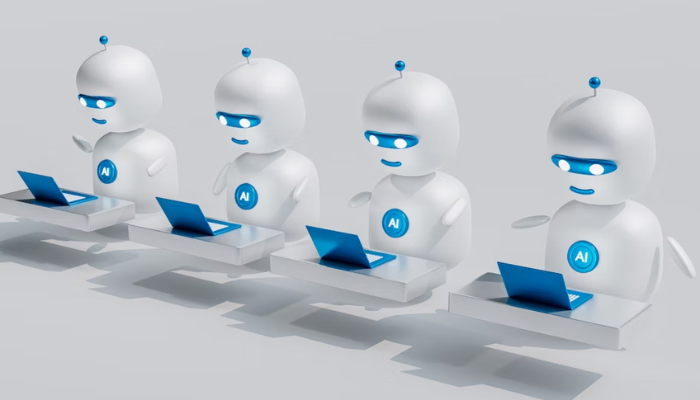Deep Learning vs Machine Learning: Unlocking the Power of AI for Your Business
Artificial intelligence (AI) has moved from the realm of science fiction to become a tangible force reshaping industries and redefining how businesses operate. From automating mundane tasks to providing unprecedented insights into customer behavior, AI offers a plethora of opportunities for growth and innovation. However, navigating the landscape of AI can be daunting, especially when faced with terms like machine learning and deep learning. Understanding the nuances between these concepts is crucial for businesses looking to leverage AI effectively.
So, what exactly is the difference between Deep Learning vs Machine Learning, and more importantly, how can AI, encompassing both, benefit your business? This comprehensive guide will delve into the core principles of each, explore their distinct applications, and illuminate the tangible advantages that AI can bring to various aspects of your organization, ultimately helping you make informed decisions about AI adoption and implementation. Read on to unravel the complexities and discover how to harness the transformative potential of AI for sustainable business success.
This article will explore the core concepts of machine learning and deep learning, highlighting their differences and showcasing how both contribute to the broader field of artificial intelligence. We will delve into practical applications of AI across various industries and demonstrate the tangible benefits businesses can reap, from enhanced efficiency and improved decision-making to personalized customer experiences and the creation of new revenue streams.
Understanding the Fundamentals: Machine Learning and Deep Learning

To grasp the distinction between deep learning vs machine learning, it’s essential to first understand the overarching concept of artificial intelligence. AI refers to the broader field of computer science focused on creating machines that can perform tasks that typically require human intelligence. Both machine learning and deep learning are subfields of AI, with deep learning being a more specialized and advanced subset of machine learning.
What is Machine Learning?
At its core, machine learning is about enabling computers to learn from data without being explicitly programmed. Instead of relying on pre-defined rules, machine learning algorithms identify patterns, make predictions, and improve their performance over time as they are exposed to more data. This learning process involves feeding algorithms with labeled data (data with known outcomes) or unlabeled data, depending on the type of learning (supervised, unsupervised, or reinforcement learning).
Common examples of machine learning in action include:
- Spam filters: Identifying and filtering unwanted emails based on patterns in email content and sender information.
- Recommendation systems: Suggesting products or content to users based on their past behavior and preferences.
- Fraud detection: Identifying potentially fraudulent transactions by analyzing patterns in financial data.
- Image classification: Categorizing images based on their visual content.
Machine learning algorithms typically rely on handcrafted features, meaning that domain experts need to identify and engineer the relevant features from the raw data that the algorithm will use for learning. This feature engineering process is a crucial step in traditional machine learning.
Diving Deeper: What is Deep Learning?
Deep learning, on the other hand, takes machine learning a step further by utilizing artificial neural networks with multiple layers (hence the term "deep"). These deep neural networks are inspired by the structure and function of the human brain and are capable of automatically learning complex patterns and representations directly from raw data, eliminating the need for manual feature engineering in many cases.

The key innovation in deep learning lies in its ability to learn hierarchical representations of data. Each layer in the neural network learns increasingly abstract and complex features from the output of the previous layer. For example, in image recognition, the initial layers might learn basic features like edges and corners, while deeper layers learn more complex features like shapes, objects, and eventually, entire scenes.
Deep learning has achieved remarkable success in areas where traditional machine learning algorithms struggled, including:
- Natural Language Processing (NLP): Understanding and processing human language, powering applications like chatbots, machine translation, and sentiment analysis.
- Computer Vision: Analyzing and understanding visual information, enabling tasks like object detection, facial recognition, and autonomous driving.
- Speech Recognition: Converting spoken language into text.
- Time Series Analysis: Analyzing data points indexed in time order, such as stock prices or weather patterns.
While deep learning models can achieve state-of-the-art performance, they typically require significantly larger amounts of data and computational power for training compared to traditional machine learning algorithms.
| Feature | Machine Learning | Deep Learning |
| Feature Engineering | Often requires manual feature extraction and selection | Automatically learns features from raw data |
| Data Requirements | Can work well with smaller datasets | Typically requires large amounts of data for optimal performance |
| Computational Power | Generally lower computational requirements | Higher computational requirements, often requiring GPUs |
| Algorithm Complexity | Simpler algorithms (e.g., linear regression, decision trees, support vector machines) | Complex artificial neural networks with multiple layers |
| Problem Complexity | Works well for well-defined problems with clear features | Excels at complex tasks like image recognition, NLP, and speech recognition |
| Interpretability | Often more interpretable (easier to understand how a decision was made) | Can be a "black box," making it harder to interpret decisions |
How AI Benefits Business: Leveraging Machine Learning and Deep Learning

The advancements in both machine learning and deep learning have unlocked a wide range of opportunities for businesses to enhance their operations, improve customer experiences, and drive growth. Here are some key ways AI benefits business:
- Enhanced Efficiency and Automation: AI-powered tools can automate repetitive and time-consuming tasks, freeing up human employees to focus on more strategic and creative endeavors. This includes automating data entry, customer service inquiries through chatbots, and even manufacturing processes.
- Improved Decision-Making: Machine learning algorithms can analyze vast amounts of data to identify patterns and trends that humans might miss. This enables businesses to make more informed decisions in areas like inventory management, pricing strategies, and market forecasting.
- Personalized Customer Experiences: AI can analyze customer data to understand individual preferences and behaviors, allowing businesses to deliver personalized recommendations, marketing messages, and customer support, leading to increased customer satisfaction and loyalty.
- Predictive Analytics: By analyzing historical data, machine learning models can predict future trends and outcomes, such as potential customer churn, equipment failures, or market shifts, enabling businesses to take proactive measures.
- Fraud Detection and Security: AI-powered systems can analyze patterns in real-time to identify and prevent fraudulent activities, protecting businesses and their customers from financial losses and security breaches.
- New Product and Service Development: AI can be used to analyze customer needs and market trends, identify unmet demands, and even assist in the design and development of innovative new products and services.
Real-World Applications of AI in Business
The benefits of AI for business are evident across various industries. Here are a few examples:
- Retail: Personalized product recommendations, dynamic pricing, inventory optimization, fraud detection in online transactions, and AI-powered chatbots for customer service.
- Finance: Algorithmic trading, fraud detection, risk assessment, credit scoring, and personalized financial advice.
- Healthcare: Disease diagnosis, drug discovery, personalized treatment plans, medical image analysis, and robotic surgery.
- Manufacturing: Predictive maintenance of equipment, quality control, robotic automation, and supply chain optimization.
- Marketing: Personalized advertising, customer segmentation, sentiment analysis of customer feedback, and content generation.
Conclusion: Embracing the AI Revolution
The distinction between deep learning vs machine learning lies primarily in the complexity of their algorithms and their ability to automatically learn features from data. While machine learning has provided significant advancements, deep learning has opened up new possibilities for tackling more complex and data-rich problems. Ultimately, both are powerful tools within the broader field of artificial intelligence, offering significant benefits for businesses across various sectors. By understanding their capabilities and limitations, organizations can strategically leverage AI to drive innovation, enhance efficiency, and achieve their business objectives.
Ready to explore how AI, including machine learning and deep learning, can transform your business? Contact our team of AI experts today for a consultation and discover tailored solutions to meet your specific needs.









